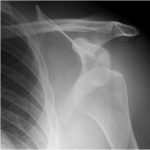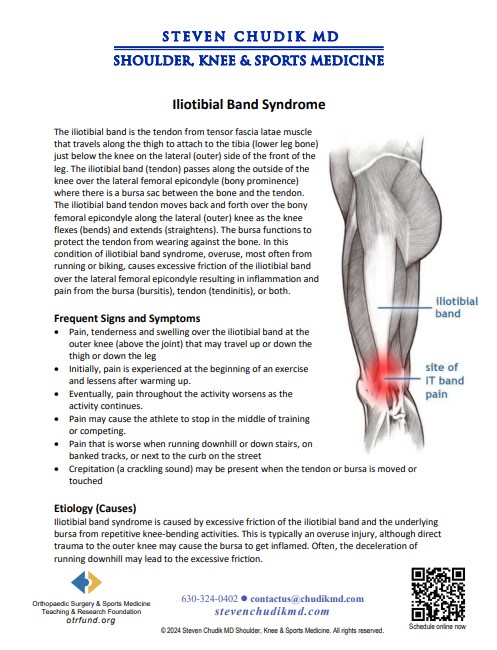 Arthroscopic expert, Dr. Steven Chudik, cites prompt treatment, thorough evaluation and physical therapy as key factors to successful return from shoulder dislocation injury
Arthroscopic expert, Dr. Steven Chudik, cites prompt treatment, thorough evaluation and physical therapy as key factors to successful return from shoulder dislocation injury
The iliotibial band is the tendon attachment of hip muscles into the lower leg (tibia) just below the knee on the lateral (outer) side of the front of the leg. The iliotibial band (tendon) passes along the outside of the knee over the lateral femoral epicondyle (bony prominence) where there is a bursa sac between the bone and the tendon. The iliotibial band tendon moves back and forth over the femoral epicondyle along the lateral(outer) knee as the knee flexes and extends passes in front and behind it. The bursa functions to reduce friction and wear of the tendon against the bone. In this condition of iliotibial band syndrome, overuse, most often from running or biking, causes excessive friction of the iliotibial band over the lateral femoral epicondyle, resulting in inflammation and pain from the bursa (bursitis), tendon (tendinitis), or both.
Iliotibial band syndrome is caused by excessive friction of the iliotibial band and the underlying bursa due to repetitive knee-bending activities. This is an overuse injury, although direct trauma to the outer knee may cause the bursa to get inflamed. Often the deceleration of running down hills may lead to the excessive friction.
Initial treatment consists of medication and ice to relieve the pain, stretching and strengthening exercises (particularly the iliotibial band), and modification of the activity that initially caused the problem. These all can be carried out at home, although referral to a physical therapist or athletic trainer for further evaluation and treatment may be helpful. Orthotics (arch supports) for the shoe in those with tight iliotibial bands may be prescribed to reduce friction to the bursa. A knee sleeve or bandage may help keep the tendon and bursa warm during activity and reduce some symptoms. Training techniques can be altered by lessening the amount of the training activity, changing the stride length, or avoiding running on hills or stairs, changing the direction you run on a circular or banked track, or changing the side of the road you run on if you run next to the curb in the same direction all the time. Cyclists may need to change the seat height or foot position on their bicycles. An injection of cortisone into the bursa may be helpful and recommended. Surgery to remove the inflamed bursa and part of the scarred or inflamed iliotibial band is usually only considered after at least six months of conservative treatment.
Learn More
Content provided by Dr. Chudik not to be used for diagnosis and treatment. You can receive a proper evaluation and diagnosis by making an appointment with Dr. Chudik